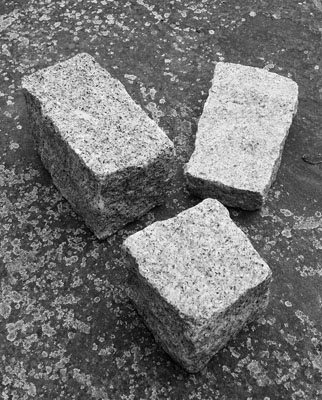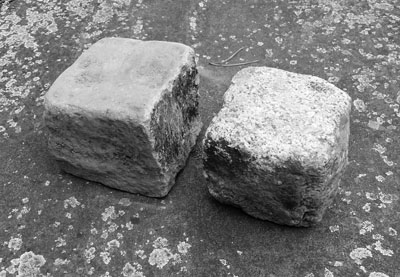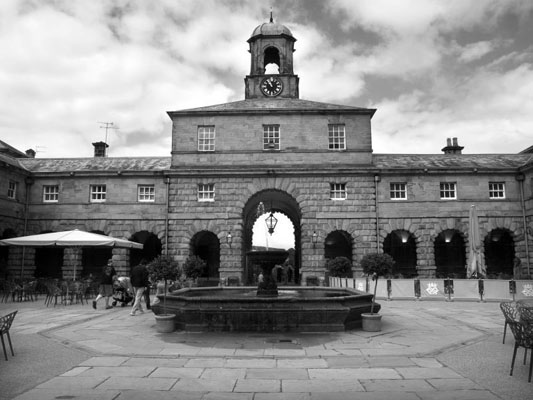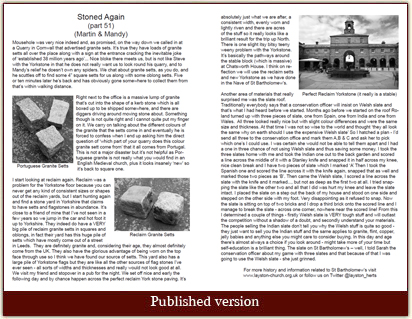Martin & Mandy
Mousehole was very nice indeed and, as promised, on the way down we called in at a Quarry in Cornwall that advertised granite sets. It's true they have loads of granite setts all over the place along with a sign at the entrance cracking the inevitable joke of 'established 38 million years ago'... Nice bloke there meets us, but is not like Steve with the Yorkstone in that he does not really want us to look round his quarry, and to Mandy's relief he doesn't own any spiders. We chat about granite setts, as you do, and he scuttles off to find some 4" square setts for us along with some oblong setts. Five or ten minutes later he's back and has obviously gone somewhere to collect them from that's within walking distance.
 Right next to the office is a massive lump of granite that's cut into the shape of a kerb stone which is all boxed up to be shipped somewhere, and there are diggers driving around moving stone about. Something though is not quite right and I cannot quite put my finger on it. We carry on talking about the different colours of the granite that the setts come in and eventually he is forced to confess when I end up asking him the direct question of 'which part of your quarry does this colour granite sett come from' that it all comes from Portugal. This is not a major disaster but it's not helpful as Portuguese granite is not really what you would find in an English Medieval church, plus it looks insanely 'new' so it's back to square one.
Right next to the office is a massive lump of granite that's cut into the shape of a kerb stone which is all boxed up to be shipped somewhere, and there are diggers driving around moving stone about. Something though is not quite right and I cannot quite put my finger on it. We carry on talking about the different colours of the granite that the setts come in and eventually he is forced to confess when I end up asking him the direct question of 'which part of your quarry does this colour granite sett come from' that it all comes from Portugal. This is not a major disaster but it's not helpful as Portuguese granite is not really what you would find in an English Medieval church, plus it looks insanely 'new' so it's back to square one.
 I start looking at reclaim again. Reclaim was a problem for the Yorkstone floor because you can never get any kind of consistent sizes or shapes out of the reclaim yards, but I start hunting again and find a stone yard in Yorkshire that claims to have setts and flagstones in abundance. It's close to a friend of mine that I've not seen in a few years so we jump in the car and hot foot it up to Yorkshire. They indeed do have a VERY big pile of reclaim granite setts in squares and oblongs, in fact their yard has this huge pile of setts which have mostly come out of a street in Leeds. They are definitely granite and, considering their age, they almost definitely come from the UK. They also have the glorious advantage of being worn on the top face through use so I think we have found our source of setts. This yard also has a large pile of Yorkstone flags but they are like all the other sources of flag stones I've ever seen - all sorts of widths and thicknesses and really would not look good at all. We visit my friend and stopover in a pub for the night. We set off nice and early the following day and by chance happen across the perfect reclaim York stone paving. It's absolutely just what we are after, a consistent width, evenly worn and lightly riven and there are acres of the stuff so it really looks like a brilliant result for the trip up North. There is one slight itsy bitsy teeny weeny problem with the Yorkstone. It's basically the pathways around the stable block (which is massive) at Chatsworth House. I think on reflection we will use the reclaim setts and new Yorkstone as we have done in the Nave of St Bartholomew's.
I start looking at reclaim again. Reclaim was a problem for the Yorkstone floor because you can never get any kind of consistent sizes or shapes out of the reclaim yards, but I start hunting again and find a stone yard in Yorkshire that claims to have setts and flagstones in abundance. It's close to a friend of mine that I've not seen in a few years so we jump in the car and hot foot it up to Yorkshire. They indeed do have a VERY big pile of reclaim granite setts in squares and oblongs, in fact their yard has this huge pile of setts which have mostly come out of a street in Leeds. They are definitely granite and, considering their age, they almost definitely come from the UK. They also have the glorious advantage of being worn on the top face through use so I think we have found our source of setts. This yard also has a large pile of Yorkstone flags but they are like all the other sources of flag stones I've ever seen - all sorts of widths and thicknesses and really would not look good at all. We visit my friend and stopover in a pub for the night. We set off nice and early the following day and by chance happen across the perfect reclaim York stone paving. It's absolutely just what we are after, a consistent width, evenly worn and lightly riven and there are acres of the stuff so it really looks like a brilliant result for the trip up North. There is one slight itsy bitsy teeny weeny problem with the Yorkstone. It's basically the pathways around the stable block (which is massive) at Chatsworth House. I think on reflection we will use the reclaim setts and new Yorkstone as we have done in the Nave of St Bartholomew's.
 Another area of materials that really surprised me was the slate roof. Traditionally everybody says that a conservation officer will insist on Welsh slate and that's what I had heard before we started. Months ago before we started on the roof Roland turned up with three pieces of slate, one from Spain, one from India and one from Wales. All three looked really nice but with slight colour differences and were the same size and thickness. At that time I was not so wise to the world and thought 'they all look the same why on earth should I use the expensive Welsh slate' So I hatched a plan - I'd send all three to the conservation office and mark them A,B & C and ask her to pick which one's I could use. I was certain she would not be able to tell them apart and I had a one in three chance of not using Welsh slate and thus saving some money. I took the three slates home with me and took the Indian one out to the back garden and scored a line across the middle of it with a Stanley knife and snapped it in half across my knee, nice clean break and I have two pieces of slate which I marked 'A' Then I took the Spanish one and scored the line across it with the knife again, snapped that as well and marked those two pieces as 'B'. Then came the Welsh slate, I scored a line across the slate with the knife and it marked..., but not as deep as the first two at all. I tried snapping the slate like the other two and all that I did was hurt my knee and leave the slate intact. I placed the slate on a step out the back of my house and stood on one side and stepped on the other side with my foot. Very disappointing as it refused to snap. Now the slate is sitting on top of two bricks and I drop a third brick onto the scored line and I manage to break the slate - across one corner, nowhere near the scored line! From this I determined a couple of things - firstly Welsh slate is VERY tough stuff and will outlast the competition without a shadow of a doubt, and secondly understand your materials. The people selling the Indian slate don't tell you why the Welsh stuff is quite so good - they just want to sell you the Indian stuff and the same applies to granite, flint, copper, jelly babies and anything else you might care to consider buying. In this day and age there's almost always a choice if you look around - might take more of your time but self-education is a brilliant thing. The slate on St Bartholomew's – well, I told Sarah the conservation officer about my game with three slates and that because of that I was going to use the Welsh slate - she just grinned.
Another area of materials that really surprised me was the slate roof. Traditionally everybody says that a conservation officer will insist on Welsh slate and that's what I had heard before we started. Months ago before we started on the roof Roland turned up with three pieces of slate, one from Spain, one from India and one from Wales. All three looked really nice but with slight colour differences and were the same size and thickness. At that time I was not so wise to the world and thought 'they all look the same why on earth should I use the expensive Welsh slate' So I hatched a plan - I'd send all three to the conservation office and mark them A,B & C and ask her to pick which one's I could use. I was certain she would not be able to tell them apart and I had a one in three chance of not using Welsh slate and thus saving some money. I took the three slates home with me and took the Indian one out to the back garden and scored a line across the middle of it with a Stanley knife and snapped it in half across my knee, nice clean break and I have two pieces of slate which I marked 'A' Then I took the Spanish one and scored the line across it with the knife again, snapped that as well and marked those two pieces as 'B'. Then came the Welsh slate, I scored a line across the slate with the knife and it marked..., but not as deep as the first two at all. I tried snapping the slate like the other two and all that I did was hurt my knee and leave the slate intact. I placed the slate on a step out the back of my house and stood on one side and stepped on the other side with my foot. Very disappointing as it refused to snap. Now the slate is sitting on top of two bricks and I drop a third brick onto the scored line and I manage to break the slate - across one corner, nowhere near the scored line! From this I determined a couple of things - firstly Welsh slate is VERY tough stuff and will outlast the competition without a shadow of a doubt, and secondly understand your materials. The people selling the Indian slate don't tell you why the Welsh stuff is quite so good - they just want to sell you the Indian stuff and the same applies to granite, flint, copper, jelly babies and anything else you might care to consider buying. In this day and age there's almost always a choice if you look around - might take more of your time but self-education is a brilliant thing. The slate on St Bartholomew's – well, I told Sarah the conservation officer about my game with three slates and that because of that I was going to use the Welsh slate - she just grinned.
For more history and information related to St Bartholomew's visit www.layston-church.org.uk or follow us on Twitter @layston_herts

 |
|
 |

